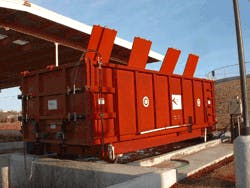Oklahoma Wastewater Plant Deals With Sludge
Weatherford, Okla., is a city with a population of about 10,000. The local wastewater treatment plant (WWTP) has a capacity of 2 MGD, but currently it is only processing a flow of 1 MGD. The drying beds built to handle the sludge generated by the plant were designed to accept and dry 100,000 gallons per month (5,000-6,000 lb dry solids). These drying beds are made of stainless steel wedge wire, and cost the city nearly $300,000 when the 6 beds were built in 1993. A population increase due to the creation of new industries in Weatherford has worsened the load on the WWTP.
Growing concerns
Jack Olson, the plant supervisor of Weatherford’s WWTP, was growing concerned about the level of solids in his basins. Even though his clarifier and aerobic digester should have been able to keep up, the drying beds could not, causing a backup of solids through the system. The cake from the drying beds was scooped up by a front-end loader and put into a manure spreader. The city has several permitted sites where the cake is then land applied. Olson became worried when the solids built up to a critical level in his digester. Occasionally, something would come through his plant, such as an accidental discharge at an industrial site, which would upset his system, killing the microbes necessary for breaking down the waste. These upsets could take weeks to control.
Wanting to stay in compliance with the regulations imposed on his plant, Olson and his superiors looked for ways to alleviate the problem.
Curing the downstream backup was high on the agenda. Olson and his team first looked at expanding their existing drying beds, because the city already owned the land; however, this would be an expensive task.
Next, Weatherford’s WWTP staff examined the option of purchasing a belt filter press. The cost of this option ranged from $150,000 to $400,000, depending on the manufacturer and size of the unit, which did not include installation or building requirements.
From interactions with nearby city plant operators, Olson heard about the Sludge Mate , a dewatering unit manufactured by Flo Trend Systems. The dewatering system includes a liquid tight container that has filter media attached to the inside walls and center support panel. As sludge is pumped to the dewatering unit, a dilute solution of polymer is added, causing the sludge to flocculate.
In concert with the dewatering system, Flo Trend also manufactures a polymer mixing and injection system, the Poly-Mate , for reaching the flocculation process. When the sludge enters the Sludge Mate in this flocculated form, the solids have clumped together and separated from the water so that water can pass easily through the filter media, leaving the solids to build up inside the container.
After letting the “cake” dry in the dewatering unit, a rear door in the unit is then opened for unloading the cake.
Because Weatherford WWTP employees were applying their sludge cake by manure spreader, it made the most sense for them to choose the permanently mounted tipping unit Sludge Mate. This allowed the cake to be dumped on a concrete pad and transferred to a manure spreader through a front-end loader.
The city decided to purchase both a Sludge Mate and a Poly-Mate . With these changes to their plant, Olson said they have gone from land applying the cake weekly to just four times a year. The facility is no longer in need of the drying beds, as the 30 cu. yd. Sludge Mate is large enough to keep up with the amount of solids being wasted.
On average, Olson said that one gallon of polymer will treat 5,200 gal. of Weatherford WWTP sludge. He was previously using polymer when wasting to his drying beds to help accelerate the drainage rate. Therefore, the cost of polymer currently required to flocculate the sludge is not substantially more than he was already paying.
Olson reports that now he is able to keep his aeration basin at 2% solids, which was always a problem in the past. Currently, when an upset comes through the system from an accidental industrial discharge, it doesn’t take long to get the plant back under control.
Charts
Click here to see the 2006 monthly totals for processing less than 1% solids from the digester through the Sludge Mate.
This chart shows the 2006 Cost of land application of sludge (including labor, fuel, and miscellaneous costs).
